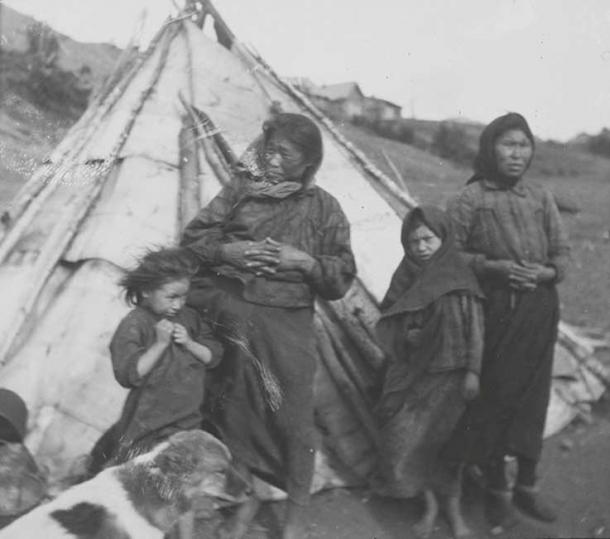
The Inexplicable Origins of the Ket People of Siberia
The Kets are an indigenous people who live in Siberia and are regarded to be one of the smallest ethnic groups in that region. Their appearance, language and traditional semi-nomadic lifestyle has scientists bewildered by their origins, with some proposing links to the native tribes of North America. There is even a Ket folklore that they came from space. What might be the true origin of these seemingly out of place people?
Ket People Settle in Siberia
The word ‘Ket’ may be translated to mean ‘person’ or ‘man’ and is the modern name of this particular Siberian ethnic group. Prior to this, however, they were known as the Ostyak, or the Yenisei-Ostyak (which is a Turkic word meaning ‘stranger’), which is a reflection of the area where they lived. The Ket originally settled in the middle and lower basin of the Yenisei River, which is located in the present day Krasnoyarsk Krai of Russian federal district of Siberia.
They traditionally had a nomadic existence, hunting and trading fur from animals such as squirrel, fox, deer, hare and bear with Russian traders. They built tents from wood, birch bark and pelts and would, breed reindeer and fish from canoes. Many of these activities are practiced to this day.
- Charred Turnip Dinner From 400 Years Ago Throws New Light on Conquest of Siberia
- Found: Grave of Siberian Noblewoman up to 4,500-Years-Old With Links to Native Americans
- Extinct Denisovans from Siberia Made Stunning Jewelry. Did They Also Discover Australia?

Boats of the Yenisei-Ostiaks preparing to start from Sumarokova. (Public Domain)
Whilst the Ket population has been remarkably stable during the 20 th century, remaining at around 1000 members, there has been a gradual decline in the number of native speakers of the Ket language. This language is unique, as it is considered to be a ‘living linguistic fossil’. Linguistic studies conducted on the Ket language have led to the theory that these people are somehow related to certain Native American tribes of North America, and that the latter had migrated from Siberia many millennia ago.
Ket Folklore
According to one Ket legend, the Kets were aliens who came from the stars. Another legend states that the Kets originally settled in the southern part of Siberia, either in the area around the Altai and Sayan Mountains, or between Mongolia and Lake Baikal. The arrival of invaders in the area, however, forced the Kets to flee to the Siberian taiga in the north. The legends state that these invaders were the Tystad, or ‘stone people’, who may have been some of the peoples who formed the early steppe confederations of the Huns. It has also been suggested that these peoples were nomadic reindeer pastoralists and horse herders.
- The Last of the Siberian Unicorns: What Happened to the Mammoth-Sized One-Horned Beasts of Legend?
- Extinct Cave Lion Cub in ‘Perfect’ Condition Found in Siberia Raising Cloning Hopes
- Oldest Paleolithic Rock Art in Siberia May Be More Ancient than Previously Believed

Ket Women and Children, 1913. (Public Domain)
Puzzling Language of the Ket People
It may be said that the most intriguing aspect of the Kets is their language. For a start, the Ket language is unlike any other language spoken in Siberia. In fact, this language belongs to a linguistic group known as Yeniseian, which consists of a number of related languages that were spoken in the Yenisei region. Apart from the Ket, all the other languages in this family are now extinct. The Yugh language, for instance, was declared extinct in 1990, whilst the rest, including the Kott and Arin languages, died out by the 19 th century.
It is feared that the Ket language will also die out in the future. According to censuses conducted over the 20 th century, the Ket population has been stable over the decades, neither increasing nor decreasing drastically. What is alarming, however, is the fact that there has been a decline in the number of Kets who are able to speak their native language. In the 1989 census, for instance, a total of 1113 Kets were recorded. Nevertheless, only about half of them were able to speak the Ket language, and the situation has been deteriorating. In an Al Jazeera report from 2016, for instance, it was claimed that there were “perhaps only a few dozen fully fluent speakers left – and these are mostly over 60 years old”.

Houseboats of the Kets, 1914. (Public Domain)
North American Origins?
The Ket language has attracted the attention of linguists as it is believed that this language is derived from a proto-Yeniseian language that may have been related to such diverse languages as Basque in Spain, Barushaski in India, as well as Chinese and Tibetan. Edward Vajda, a historical linguist at Western Washington University, has even hypothesised that the Ket language may be related to the Na-Dene language family of North America, which includes such languages as Tlingit and Athabaskan.
Finally, it has been pointed out that if Vajda’s hypothesis turns out to be true, it would be quite a significant finding, as it would shed more light on the question of how the Americas was settled. Apart from linguistic connections, researchers have also sought to establish genetic connections between the Kets and Native Americans to further support the migration hypothesis. This attempt, however, has not been very successful. Firstly, the few DNA samples that were obtained may have been contaminated. Secondly, Native Americans often refuse to provide DNA samples, and hence the DNA samples for native South Americans were used instead.
Top image: Ket People, Native Peoples of Siberia. Black and White Photo, 1900s. (Public Domain)
By: Wu Mingren
References
Arctic Athabaskan Council, 2018. Kets of Russia and Athabaskan Peoples of North America. [Online]
Available at: http://www.arcticathabaskancouncil.com/aac/?q=node/18
Joshua Project, 2018. Kets, Yenisei Ostyak in Russia. [Online]
Available at: https://joshuaproject.net/people_groups/16023/RS
Kazakevich, O., 2005. The Ket Language. [Online]
Available at: http://lingsib.iea.ras.ru/en/languages/ket.shtml
Mirovalev, M., 2016. Tracing ancient Asia-America migration in language. [Online]
Available at: https://www.aljazeera.com/indepth/features/2016/05/tracing-ancient-europe-america-migration-language-160502114625405.html
The Editors of Encyclopaedia Britannica, 2016. Ket. [Online]
Available at: https://www.britannica.com/topic/Ket
ToDiscoverRussia, 2018. Ket Means 'A Man'. [Online]
Available at: https://todiscoverrussia.com/ket-means-a-man/
Vajda, E. J., 2018. The Ket and Other Yeniseian Peoples. [Online]
Available at: http://pandora.cii.wwu.edu/vajda/ea210/ket.htm
Viires, A., 1993. The Kets. [Online]
Available at: https://www.eki.ee/books/redbook/kets.shtml
















Comments
They were survivors of the very brave tribe of New York Natives called the Nehantucket. They fought the colonizers as if they didn’t care about death. But advisors from their fellow Eastern tribe told them to preserve at least some of their authentic features thus they were transported to Siberia. This is why their language, features etc is some how alien to their current location. Probably they crossed by land towards Alaska or by sea towards Greenland – > arctic → siberia. https://en.wikipedia.org/wiki/Niantic_people